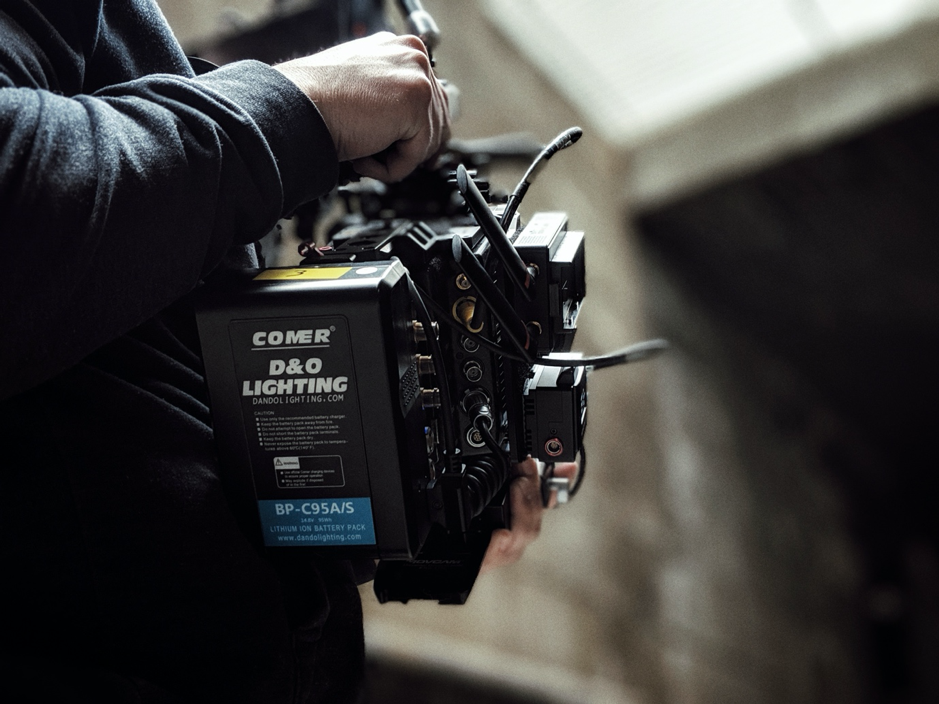
Caring for V Mount Lithium Ion Battery Packs
What is a v mount battery?
V mount, or v lock, batteries, are large capacity batteries used to power high-end cameras, LED lighting, monitors, microphones, and other compatible equipment.

-The v mount term describes the mounting system the batteries use to attach to the devices they power. Internally, V-mount battery packs contain a series of smaller lithium-ion cells wired together to produce the power capacity stated on the label.
A v mount battery / batteries are usually larger and heavier than the typical portable battery setup and take longer to charge. However, these are minor sacrifices considering that a high capacity V-mount system will deliver power for an entire day from just a few batteries.

D&O Lighting v mount batteries are available at competitive prices, but even so, they are not an insignificant investment for your kit. Making sure you squeeze every last drop of power out of them before a replacement can significantly reduce your overall ownership cost.

Lithium ion batteries are a widely adopted technology for portable power and power everything from smartphones to LED lighting. However, despite their widespread use, there is some confusion about how best to care for them to prolong their service life. Read on to find out how you can get the most out of your lithium-ion battery pack.
What's in a D&O Lighting v mount Battery?

The plastic case of your v mount battery from D&O lighting hides a bank, or banks of 18650 lithium ion battery cells arranged in series and parallel to achieve the desired power requirements.
The 18650 lithium ion battery is somewhat of a standard in the portable power supply industry, with millions of these units found in lithium ion battery / battery packs of all shapes and sizes, including our d&o lighting v mount battery. The first four digits of the number indicate the physical dimensions (18mm by 65mm), while the 0 at the end shows that it is a cylinder cell. The 18650 lithium ion battery is available in a few different variations, including a button top and an internal protection circuit.

Advantages for getting the most out of your v mount batteries
The most significant advantage you will receive from caring for your lithium ion battery pack is a financial one. A typical v mount system can add anywhere between 5% and 50% to the equipment's overall cost. Anything that prolongs the batteries' lives will reduce the total cost of ownership and increase profit margins for professionals.
There are also advantages to the environment. While lithium-ion batteries are among the most eco-friendly portable power solutions, there is still an environmental cost from mining materials, greenhouse gas emissions, and disposal.
Factors Affecting the battery Health level and how to keep your lithium ion battery health
There are three main variables related to lithium-ion batteries' health and longevity: state of charge, current, and temperature.

Charging speed, depth of discharge, and loading will also affect our d&o lighting v mount battery / batteries’ useful life. When you exercise some care over these variables, you can significantly increase your lithium ion battery/s lifespan.
How Lithium ion Batteries Degrade
Degradation in a battery's performance occurs in two different ways: capacity and power. Capacity refers to the amount of energy a battery can store, and power refers to the level of power it can output.
Internal discharge and resistance also play a role in a battery's performance, even though they have less of an impact when predicting how long a battery will last.
Lithium ion battery / batteries degrade with use but can still be useful even with reduced energy storage and power outputs. Eventually, though, the degradation will reach a point where the batteries will no longer be an efficient source of power and need replacing. A battery that won't charge to more than 70% capacity is considered by many manufacturers to be the point of no return.
How Long Do Lithium-Ion Batteries Last?
A battery generates power through the flow of ions from the positive electrode to the negative. This system would never degrade in a perfect world, but battery cycles, temperatures, and age combine to diminish battery performance over time.
Most manufacturers will measure the life of a battery in cycles. One cycle refers to the time it takes to go from 100% to 0% charge. If you deplete a battery's capacity by 20% for each use, it will take five such uses to complete one cycle. We should note that counting the usable life in cycles is not accurate due to the many other variables that can affect their performance.
Because cycles are so difficult to predict for a battery out in the wild, most manufacturers err on the conservative side when stating how long they will last, with lithium-ion batteries generally falling into the range of between 300 and 500 cycles of charge and discharge.
Some suppliers may also use a date stamp when suggesting a battery's end of life. This system fails to take cycles into account, and light usage and careful battery management can see the batteries last well beyond this date.
Caring for your V Mount Battery
A good quality battery will deliver 100%, or close to it, in its first year of life. However, just like mechanical devices, the more you use a battery, the faster it will approach its end of life. Use these tips to get the most out of your v mount investment.

Don't Completely Discharge a Lithium Ion Battery
In lithium ion batteries, the depth of discharge (DoD) is critical in how long it will last. If you can manage smaller discharges and keep some charge in the battery between uses, you will significantly increase your battery's lifespan.
Li-On batteries do not develop a 'memory,' and small discharges are perfectly fine. Nor do you need to drain the battery entirely between discharge cycles.
When you discharge lithium-ion batteries to between 2.5 and 2.9 volts per cell, an inbuilt safety circuit flicks on, and the battery will appear to be dead and unusable. This state is known as the sleep state and is designed to safeguard the battery against abuse.
A lithium-ion battery in a sleep state will not be available for immediate use, and the standard lithium-ion battery charger will not be able to reverse it. You will need to use a battery analyzer with a boost or 'wake-up' function for a chance to bring the battery back to a usable state.
Consider Purchasing Higher Capacity Batteries

As you know, the harder a battery works, the quicker it will degrade. Even batteries you are not using regularly need careful maintenance between uses to ensure their long-life. This is why you should consider your battery health maximum capacity, or how much you should use it, switch it out, and recharge it.
It may be worthwhile investing in larger capacity batteries rather than spare batteries of equal capacity. The additional expense will be more than made up with the extra life you will get out of them.
When calculating your power usage, add in all the equipment that will be drawing from the battery to ensure you do not exceed its rated power capacity.

V-Mount Battery Storage
Even when not in use, a battery will slowly self-discharge over time, so carefully storing your V-mount batteries will help you get more service out of them. Use a V-mount powered device with a gauge to determine the level of charge before you place any of your batteries in storage.
A quality lithium-ion battery charger from D&O lighting may also have a handy state of discharge indicator to help you store your batteries safely with the necessary charge level. If you have a battery that has been stored with a charge lower than 1.5V for more than a week, you should discard it.
The level of charge is not the only issue you will contend with when storing your V-mount batteries, as temperature and humidity can also play a role.
Temperature - You may not have as much control over the ambient temperature as you would like, but the ideal storage temperature for a lithium-ion is around 50°F (10°C). Higher temperatures will cause the battery to self-discharge faster.
Excessively high temperatures will also cause lithium-ion cells to deteriorate much faster, which is the main reason why you should never leave your V-mount batteries (or mobile phone) out in the sun or on the dash of your vehicle.
If the battery manages to fall into the sleep state range, they will not be immediately usable when bringing them out of storage. You can get around this issue by ensuring you maintain the correct state of charge.
Humidity – Lithium ion battery / batteries prefer a humidity of around 50%. The biggest concern with high humidity is that moisture in the air can condense between the terminals. If the area gets too wet, it could create conditions where the battery could short and overheat. In extreme circumstances, the battery may smoke as the terminal buns out. You can prevent this scenario by ensuring you always cover your battery terminals.
In general, for short-term day-to-day or week-to-week storage, store the batteries in a fully charged state. For long-term storage of anything over a month, you should maintain a charge of around 20% to 40% (approximately 3.8 volts per cell) in a cool, dry room. Your battery management routine should include periodic checking of any batteries in storage to ensure they have an adequate charge.

Transporting V Mount Batteries
Not only do v mount lithium ion store better with a partial charge, but it's also a requirement for you to discharge them to around 30% of their capacity to render them safe for transport.
It can be difficult to accurately represent the SoC (State of Charge) for a battery, but an SoC lower than 50% is considered acceptable by transport authorities. You may also safely deplete the charge to low-battery levels, provided you immediately place the battery on a lithium ion battery charger when arriving at your destination.
V mount batteries represent a not insignificant cost for powering your setup when the mains isn't accessible. Because they have such a high capacity, they tend to be a little more expensive than your garden variety lithium-ion batteries. If you use the above tips to care for your v mount battery, you will increase the time between replacement and reduce your total cost of ownership.

Comments
Leave a comment